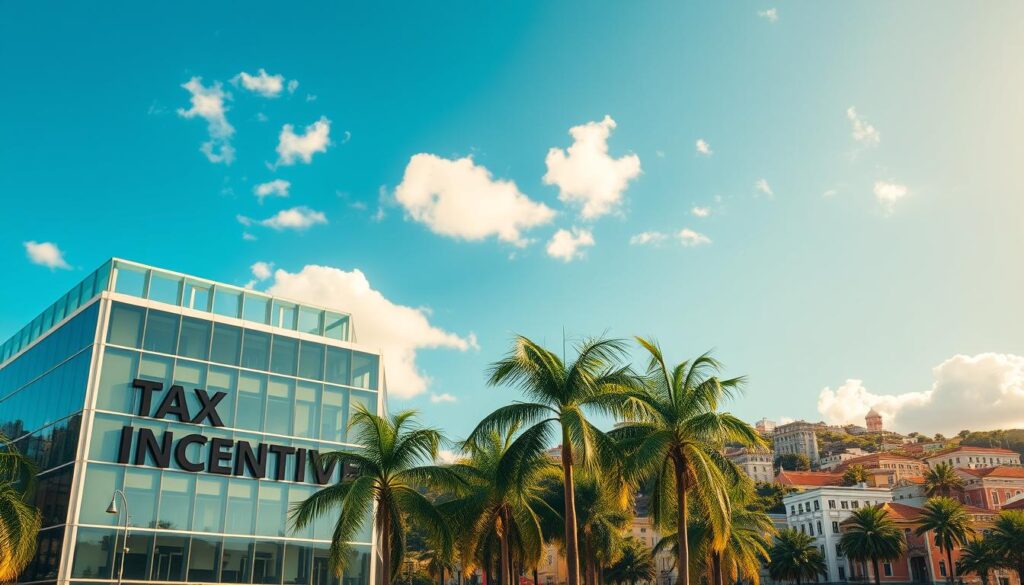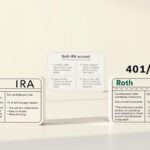Exploring Puerto Rico tax advantages could be a game-changer for your financial strategy. The island offers unique incentives under its special territorial status, making it an attractive option for businesses and investors alike.
Since 2012, Acts 20 and 22 have transformed the region into a tax-friendly hub. Qualifying businesses enjoy a 4% corporate rate, far lower than the U.S. mainland’s 21%. Individuals benefit from exemptions on dividends, interest, and capital gains.
Recent updates include cryptocurrency incentives and new advisory councils. These changes aim to boost economic growth while maintaining favorable conditions. Whether you’re an entrepreneur or investor, understanding these perks can help maximize your income potential.
Key Takeaways
- Acts 20 and 22 provide major tax incentives for businesses and individuals.
- Corporate tax rates are significantly lower than in the U.S. mainland.
- Exemptions apply to dividends, interest, and capital gains.
- New cryptocurrency incentives offer fresh opportunities.
- Recent updates ensure continued benefits through 2025.
Why Puerto Rico Is a Tax Haven for U.S. Citizens
U.S. citizens can unlock major financial advantages through Puerto Rico’s special tax structure. The island’s unique territorial status allows individual investors and businesses to leverage exclusive incentives unavailable elsewhere.
Unique Tax Advantages Under U.S. Territory Status
The IRC §933 exclusion lets bona fide residents exclude Puerto Rico-sourced income from federal taxes. Combined with Acts 20 and 22, this creates a powerful trifecta:
- 4% corporate tax for eligible services (vs. 21%+ on the mainland).
- 0% tax on local capital gains and dividends.
- No state income tax after establishing residency.
Comparing Puerto Rico to Mainland U.S. Tax Rates
Savings become stark when examining side-by-side rates:
| Tax Type | Puerto Rico Rate | Mainland U.S. Rate |
|---|---|---|
| Corporate Tax | 4% (Act 20) | 21%–37% |
| Capital Gains | 0% (post-residency) | 23.8% (federal + NIIT) |
| Dividends | 100% exempt | 20% (qualified) |
A crypto investor earning $5M in gains could save $950K by relocating. The *183-day physical presence rule* ensures compliance while maximizing benefits.
By combining Act 20 (business) and Act 22 (personal) incentives, you create a dual strategy for long-term savings.
How to Move to Puerto Rico for Tax Benefits in 2025
To unlock Puerto Rico’s financial perks, you must first establish legal residency. The process involves three critical steps, each with specific requirements to prove your commitment to the island.

Step 1: Establishing Bona Fide Residency
A bona fide resident must pass IRS tests: physical presence, tax home location, and closer connection. Documenting your move is essential. Here’s how:
- File a notarized lease or purchase property within two years.
- Update your driver’s license and voter registration promptly.
- Contribute $10k annually to local nonprofits (mandatory for some decrees).
Step 2: Meeting the 183-Day Physical Presence Rule
Spend at least 183 days annually on the island to qualify. Track your stay with a detailed calendar. Avoid frequent mainland trips—they’re common IRS audit triggers.
Pro tip: Use apps like SavvyNomad to log travel dates automatically. This simplifies compliance and avoids disputes.
Step 3: Severing Ties with Your Previous Tax Home
The IRS scrutinizes lingering mainland connections. Cut financial ties decisively:
- Close safety deposit boxes and transfer bank accounts.
- Limit medical care or social activities in your former state.
- Declare Puerto Rico as your primary tax home in all legal filings.
Follow these steps meticulously to enjoy 0% capital gains and 4% corporate rates legally.
Understanding Puerto Rico’s Tax Incentive Laws
Puerto Rico’s tax incentive laws create unmatched financial opportunities. At their core are Acts 20 and 22, designed to attract businesses and investors with generous exemptions and low rates. These laws work together to form a powerful strategy for long-term savings.
Act 20: Export Services and Corporate Tax Benefits
Under Act 20, qualifying businesses enjoy a 4% corporate tax rate—far below the U.S. mainland’s 21%. This applies to 27 service categories, including consulting, software development, and marketing. To lock in these rates:
- Apply for a tax exemption decree (takes 6–9 months).
- Maintain annual fees of $300–$5,000.
- Renew the 20-year decree for an additional decade.
Act 22: Capital Gains and Investment Tax Exemptions
Act 22 eliminates local taxes on capital gains for new residents. Key rules include:
- 0% tax on post-move investments (dividends/interest).
- 5% tax on pre-residency gains sold within 10 years.
- Establish residency by 2036 to qualify.
Note: Recent UPROAR Act proposals may challenge these exemptions. Staying informed ensures you adapt to changes.
Qualifying as a Bona Fide Resident of Puerto Rico
Becoming a bona fide resident opens doors to major tax advantages. The IRS requires clear proof of your ties to the island. Proper documentation ensures you meet all criteria.

The Physical Presence Test Explained
You must spend 183 days annually in Puerto Rico. Track your stay with GPS apps or a detailed calendar. Frequent mainland trips could trigger audits.
The 330-day foreign stay rule affects FEIE eligibility. If you exceed it, you might lose some federal exemptions. Plan travel carefully to avoid pitfalls.
Proving Puerto Rico Is Your Primary Tax Home
Your tax home must shift definitively to the island. Here’s how to demonstrate this:
- Update your driver’s license and voter registration within 60 days.
- Maintain local utility bills for at least 12 consecutive months.
- Enroll children in Puerto Rican schools (IRS values family ties).
| Proof Type | Minimum Requirement |
|---|---|
| Banking | Open a local account with recurring transactions |
| Insurance | Switch policies to Puerto Rico-based providers |
| Community | Join at least one nonprofit or club |
Avoiding the «Closer Connection» Pitfall
The IRS checks if you maintain stronger mainland ties. Cut these links decisively:
- Close unused U.S. bank accounts and safety deposit boxes.
- Limit medical care or property ownership in your former state.
- Get notarized affidavits from local professionals (e.g., accountants).
States like California aggressively challenge dual residency. Consult a tax attorney to navigate these risks.
Maximizing Savings Under Act 20 for Businesses
Act 20 transforms business operations with unmatched financial perks. By qualifying for its incentives, companies secure a 4% corporate tax rate—a fraction of mainland U.S. rates. This section breaks down eligibility, application steps, and strategies to amplify savings.
Eligible Services for the 4% Corporate Tax Rate
Over 100 NAICS codes qualify under Act 20, spanning high-value industries. Key sectors include:
- Consulting: Management, marketing, and financial advisory services.
- Crypto: Blockchain development and digital asset trading platforms.
- Software: SaaS providers and IT outsourcing firms.
To qualify, businesses must generate at least $500k annually from export services and maintain a 3:1 local-to-shareholder employee ratio. Puerto Rico also offers payroll tax credits for hiring residents, further reducing costs.
How to Apply for a Tax Exemption Decree
Securing a tax exemption decree involves a 6–9 month process. Follow these steps:
- Submit documentation: Financial statements, service descriptions, and NAICS code verification.
- Negotiate terms: Work with the PR Economic Development Department to lock in 20-year benefits.
- Comply annually: File reports proving revenue thresholds and local hiring ratios.
“A San Juan-based marketing firm slashed its tax liability by $2.1M annually under Act 20—funding expansion into Latin American markets.”
Renewals require updated applications but guarantee another decade of savings. Plan succession early to transfer decrees seamlessly.
Capital Gains Tax Strategies Under Act 22
Act 22 offers a rare chance to grow wealth tax-free in a U.S. jurisdiction. For individual investors, this law eliminates local taxes on capital gains from post-move investments. Smart planning ensures you maximize these perks while navigating IRS rules.
Tax-Free Treatment for Post-Move Investments
Once you establish residency, all new investment gains face 0% local tax. This applies to:
- Stocks, bonds, or crypto acquired after moving.
- Dividends and interest from Puerto Rico-based accounts.
- Real estate purchased post-relocation.
Example: Selling $1M in post-move Bitcoin incurs $0 tax locally. Federal taxes may still apply unless excluded under IRC §933.
Handling Pre-Residency Gains (The 5% Rule)
Assets owned before moving fall under the 5% rule. You pay 5% local tax if sold within 10 years. Key strategies:
- Tax lot selection: Sell older holdings first to minimize exposure.
- Installment sales: Spread gains over multiple years.
- Step-up basis: Inherited property resets cost basis to market value.
| Scenario | Tax Rate | Planning Tip |
|---|---|---|
| Post-move gains | 0% | Hold assets ≥1 year to avoid federal short-term rates |
| Pre-move gains (sold in Year 3) | 5% | Offset with local deductions |
| Inherited assets | 0%* | *If inherited post-residency |
“A client saved $420K on pre-move stock sales by timing transactions after Year 10.”
Crypto investors get extra flexibility—wash sale rules don’t apply. Pair Act 22 with Opportunity Zone funds for deferred federal taxes.
Navigating U.S. Federal Tax Obligations
Understanding U.S. federal tax rules while living in Puerto Rico requires careful planning. Even with territorial benefits, certain filings remain mandatory. Strategic reporting can maximize savings while staying compliant.
Reporting Puerto Rico vs. U.S.-Sourced Income
The IRS treats income differently based on its origin. These rules determine what gets reported where:
- Local income: Puerto Rico-sourced earnings qualify for IRC §933 exclusion from federal income tax.
- Mainland income: U.S.-based revenue remains fully taxable (W-2 wages, rental properties).
- Digital assets: Crypto mined/traded on the island counts as local if wallets are PR-hosted.
Example: A consultant billing $200k to PR clients and $100k to U.S. firms would only report the latter federally. Proper documentation proves sourcing.
| Income Type | Federal Filing? | PR Filing? |
|---|---|---|
| PR Business Revenue | No (if excluded) | Yes |
| U.S. Dividends | Yes | No* |
| Island Real Estate Gains | No | Yes |
*Unless reinvested locally under Act 22
Using the Foreign Tax Credit for Dual Income
The foreign tax credit (FTC) helps avoid double taxation when both jurisdictions claim income. Key considerations:
- Form 1116 thresholds: File if PR taxes exceed $300 ($600 joint).
- Credit limits: FTC can’t exceed U.S. tax on foreign-sourced income.
- Retirement accounts: 401(k) distributions may qualify for partial credits.
«California residents often owe state taxes despite PR residency. We use FTC claims to offset 20-30% of liabilities.»
For crypto traders, sourcing rules get complex. The IRS may challenge PR-sourced claims if exchanges are U.S.-based. Maintain:
- Local bank statements showing transaction flows
- Notarized logs of IP addresses during trades
- Exchange agreements specifying PR jurisdiction
Strategic filers alternate between FTC and FEIE (Foreign Earned Income Exclusion) yearly. This optimizes savings across different income tax brackets.
Common Mistakes to Avoid When Relocating
Relocating for financial advantages requires careful planning to avoid costly errors. Many individuals overlook critical steps, triggering audits or losing tax benefits. Below are key pitfalls and how to sidestep them.

Failing to Document Residency Properly
Proof of residency is non-negotiable. The IRS and Puerto Rican authorities demand clear evidence. Missing documents often lead to denied tax exemptions.
Essential records include:
- Notarized leases or property deeds (rents rose 600% since 2022—secure housing early).
- Local utility bills spanning 12+ consecutive months.
- Dated flight logs or mobile location data for the 183-day rule.
Avoid mail forwarding services—they’re red flags. Use a physical Puerto Rico address for all official correspondence.
Overlooking State Tax Domicile Rules
Some states aggressively pursue former residents. California, for example, imposes a 15-year lookback period for audits. Protect yourself:
| State | Exit Tax | Documentation Required |
|---|---|---|
| New York | Yes (income over $1M) | Form IT-201 |
| California | No, but audits common | Change of residency affidavit |
| Texas | No | Driver’s license surrender proof |
Tip: Close safety deposit boxes and transfer medical care to Puerto Rico. These actions prove you’ve severed ties.
“Clients who kept U.S. bank accounts faced $50K+ in back taxes. Cut financial ties completely.”
Dependents complicate filings. If children attend mainland schools, states may argue your tax home hasn’t changed. Enroll them locally to strengthen your case.
Long-Term Planning for Puerto Rico Tax Benefits
Strategic planning ensures your Puerto Rico tax advantages remain strong for decades. Proactive steps protect your benefits against policy shifts and maximize savings for investors and businesses alike.
Renewing Your Tax Exemption Decree
Act 20 and 22 decrees last 20 years, but renewal negotiations start early. Follow these tactics to secure another decade of 4% rates and 0% capital gains:
- Reapply 18 months early: Processing takes 6–9 months. Late filings risk gaps in coverage.
- Highlight local impact: Show job creation or community investments to strengthen your case.
- Leverage multi-generational trusts: Transfer decrees to heirs tax-free by structuring ownership correctly.
“Clients who renewed early locked in rates before 2025 enforcement hikes. Timing saved $2M+ per decree.”
Adapting to Potential Legislative Changes
The proposed UPROAR Act could impose an 85% tax rate on some investors. Stay ahead with these moves:
- Diversify incentives: Combine Acts 20, 22, and new crypto programs to spread risk.
- Join lobbying groups: Organizations like PREC advocate for legislative changes favoring current beneficiaries.
- Prep contingency plans: Explore Malta or Portugal residency if Act 22 exemptions sunset.
Monitor IRS 2025 initiatives closely. Increased audits target high-net-worth investors claiming territorial exemptions. Proper documentation defends your status.
FAQ
What makes Puerto Rico a tax haven for U.S. citizens?
Puerto Rico offers unique tax advantages as a U.S. territory, including lower corporate rates, capital gains exemptions, and no federal income tax on locally sourced income for bona fide residents.
How do I qualify as a bona fide resident of Puerto Rico?
You must pass the physical presence test (spending at least 183 days per year on the island) and prove Puerto Rico is your primary tax home while severing ties with your previous state.
What’s the difference between Act 20 and Act 22?
Act 20 provides a 4% corporate tax rate for export services businesses, while Act 22 offers 0% tax on capital gains, interest, and dividends for qualifying individual investors.
Conclusion
The island’s incentives offer lasting value for those who prepare correctly. Becoming a bona fide resident unlocks 0% capital gains and 4% corporate rates—but only if you document every step.
Start now to meet 2025 deadlines. A $1M investment could save $238K annually under current tax benefits. Frost Law Firm’s experts help navigate filings, while the *Taking Shelter* YouTube series breaks down complex rules.
Act before 2036: Puerto Rico’s Act 22 window won’t last forever. Your financial future starts with one decision—make it today.



